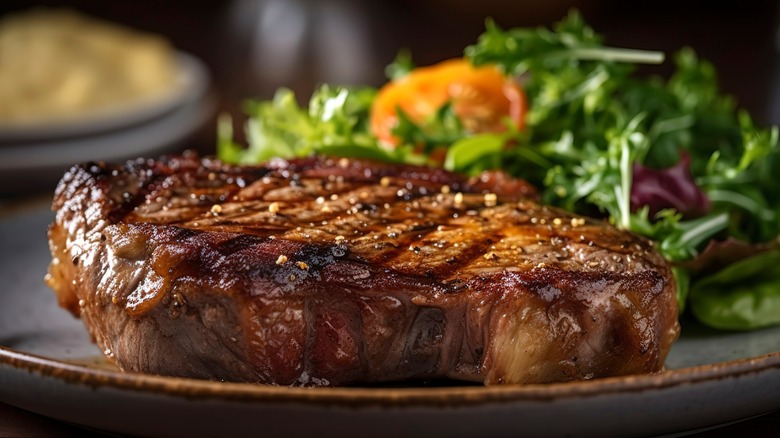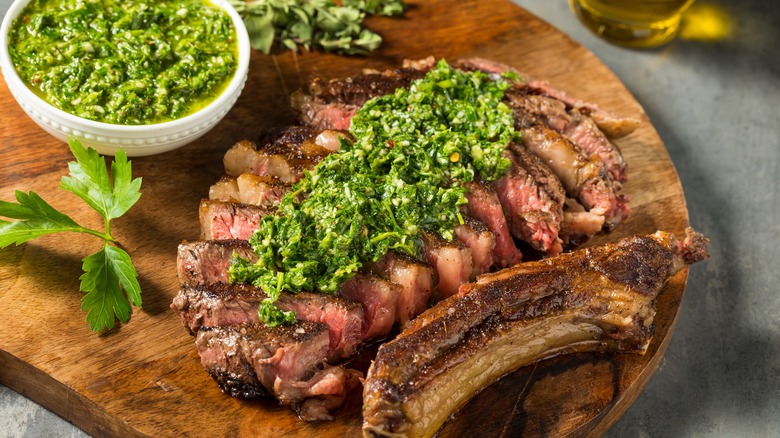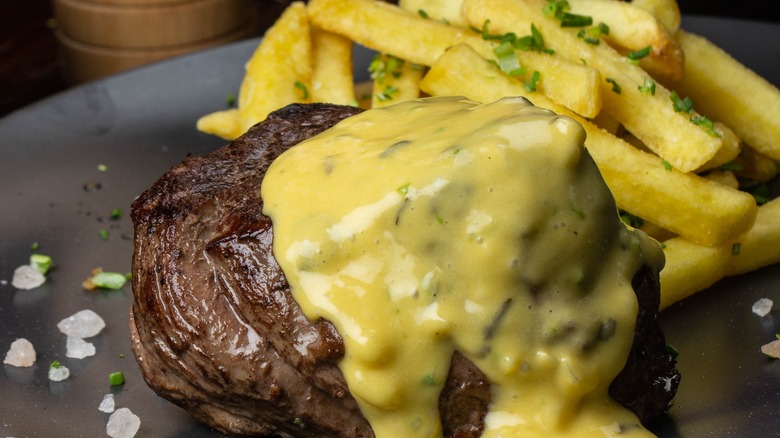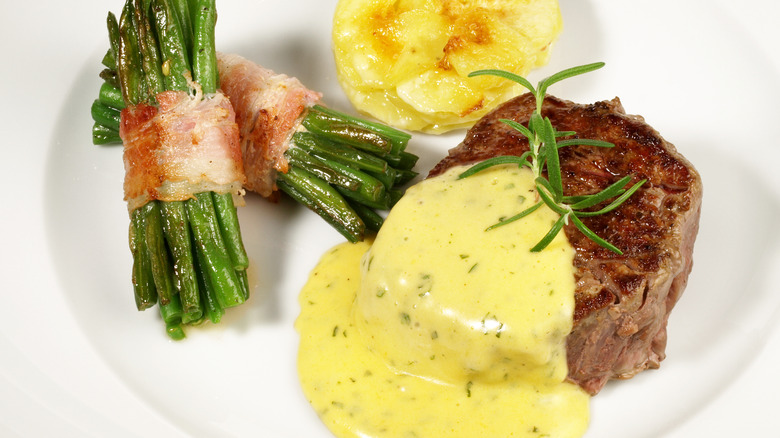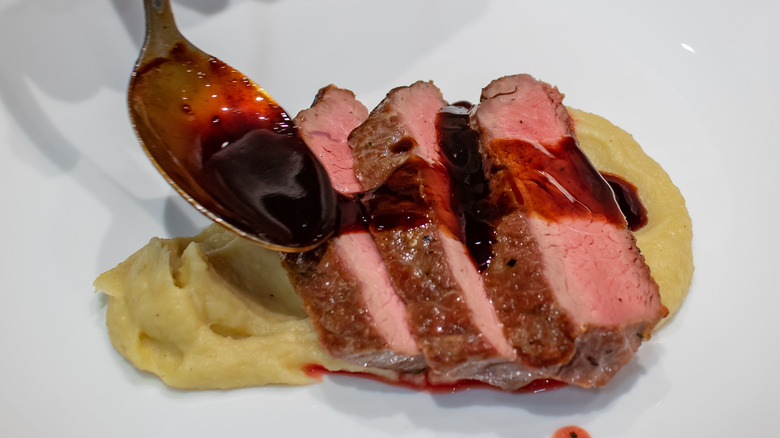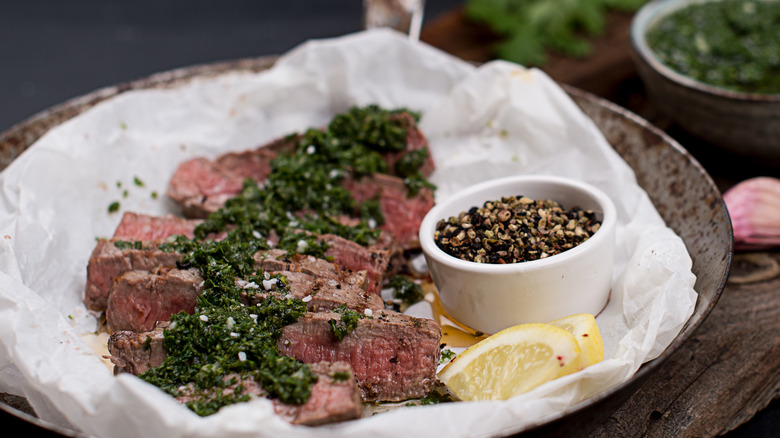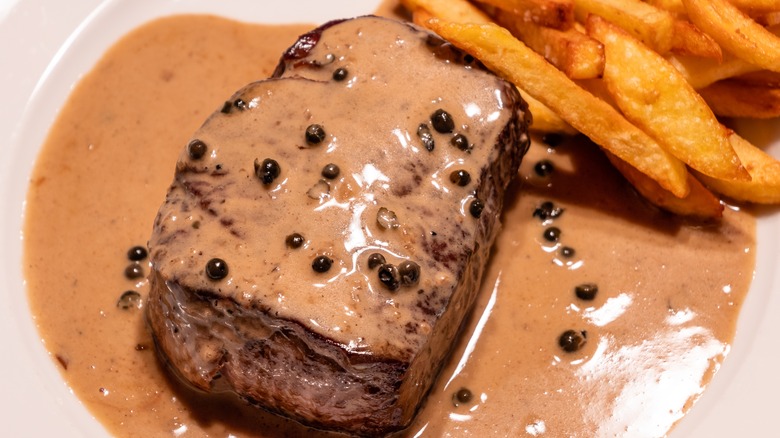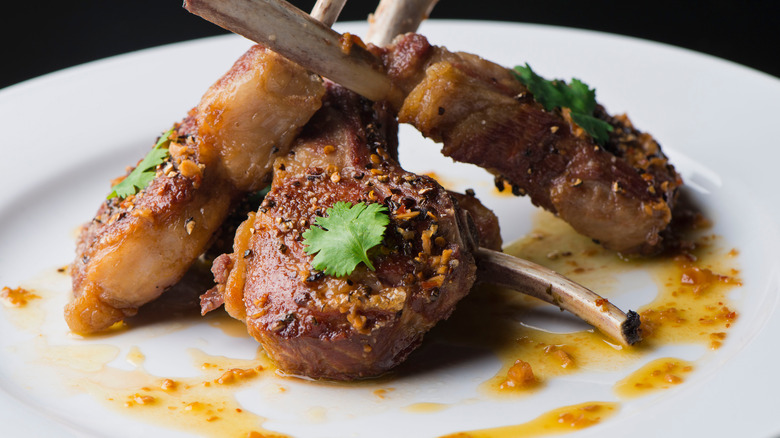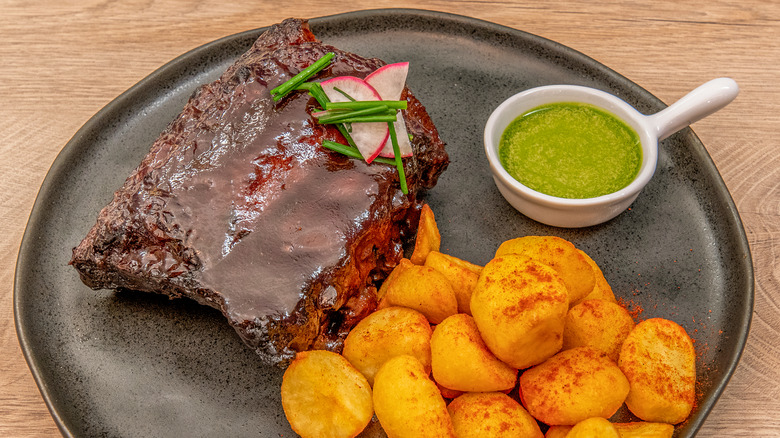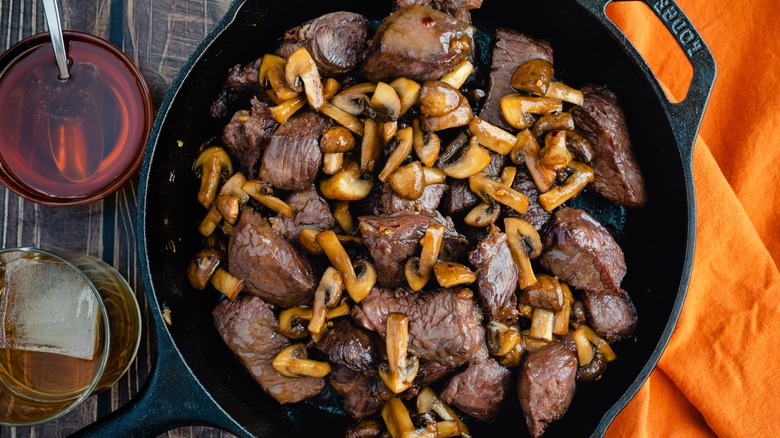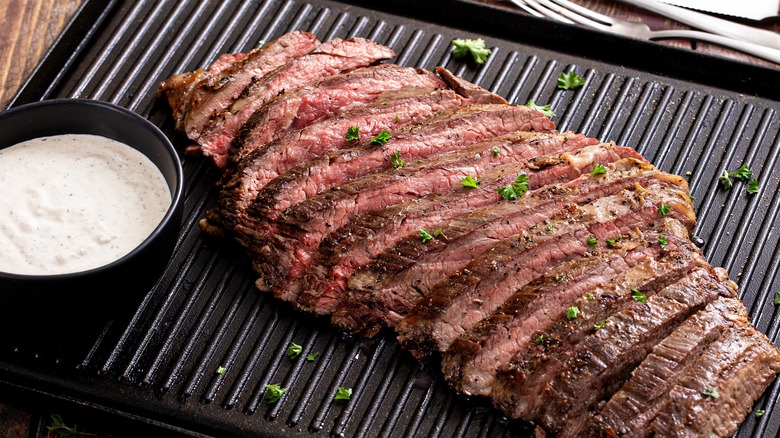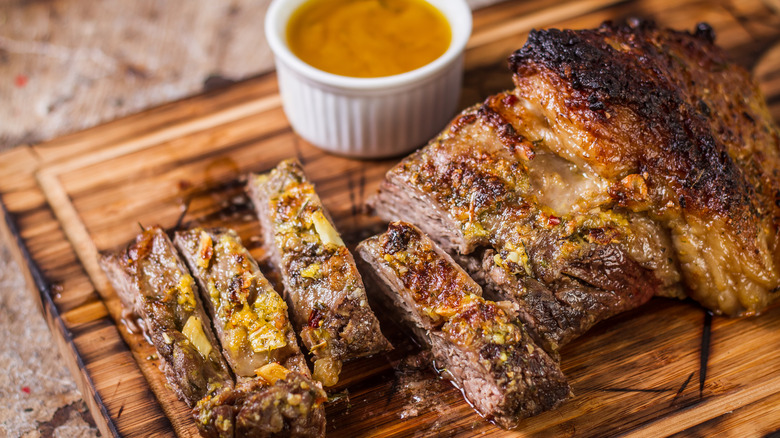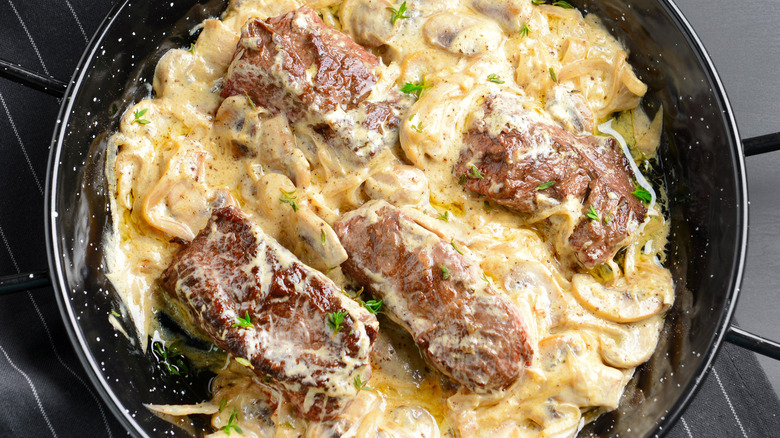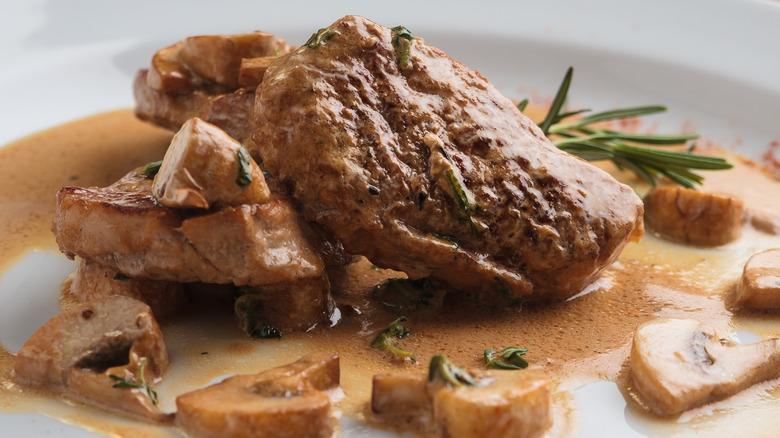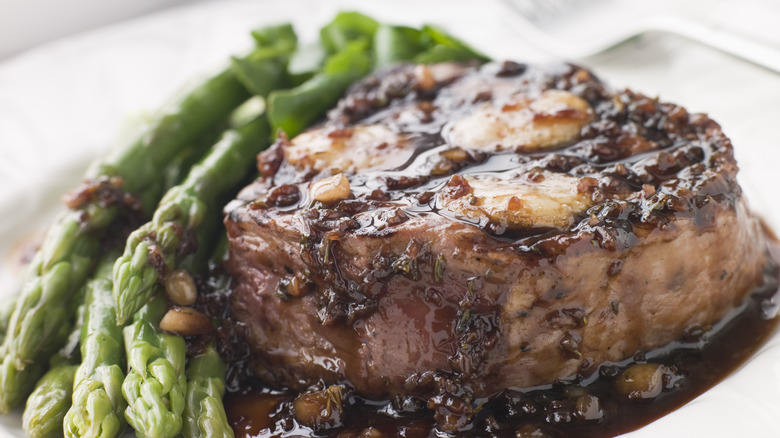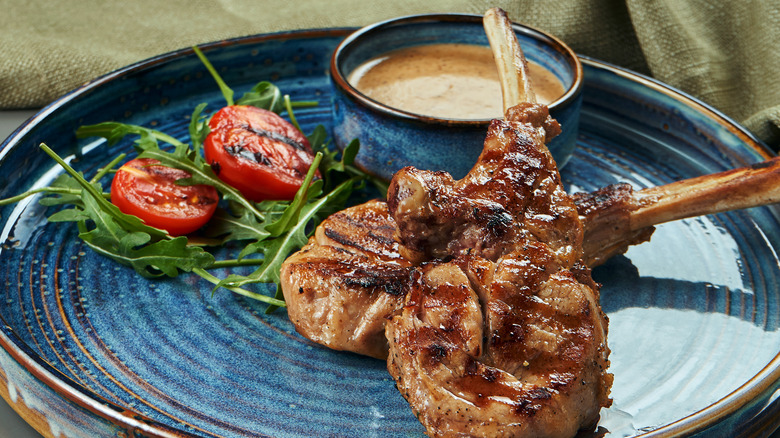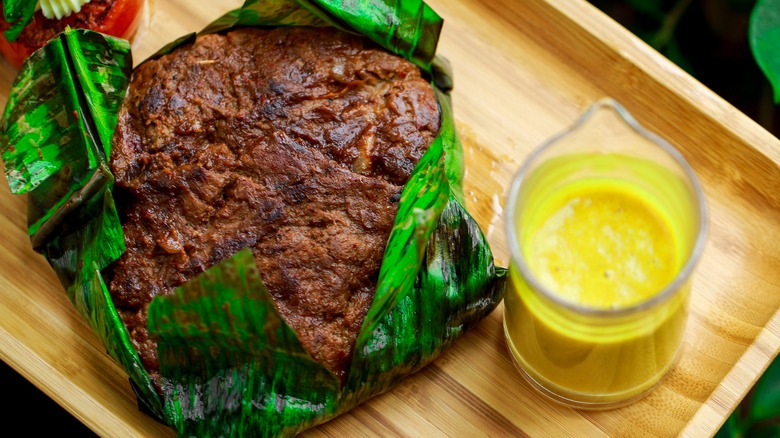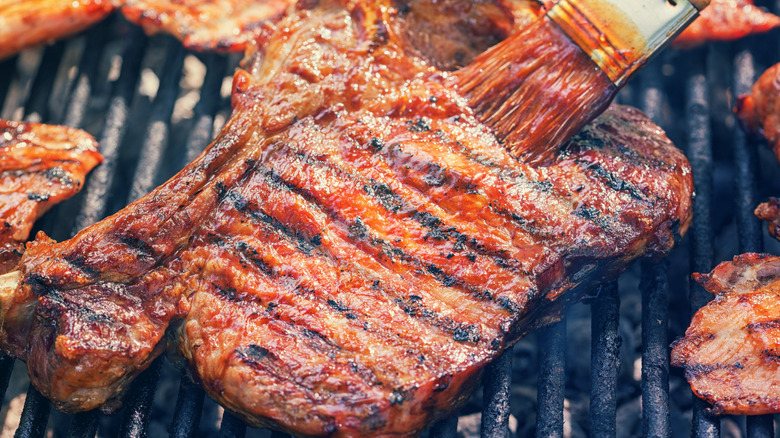17 Sauces To Boost Your Steak Meal
From filet mignon to ribeye, and from New York strip to T-bone, steak is one of the most incredible meats you can put on your plate. Everybody has a favorite cut of steak, and many consider this protein powerhouse not only the ultimate comfort food, but also a delightful indulgence.
Our passion for beef's choicest offering makes sense. Steak is tender and juicy, with beautiful — and flavorful — marbling. It caramelizes wonderfully, whether you cook it on your backyard grill, broil it in a cast-iron skillet, or sear it to perfection on the stovetop. With its world-class flavor, steak is also infinitely versatile. You can pair it with hearty mac and cheese or potatoes, but also freshly made salads and all kinds of vegetable-based sides.
Steak really is a perfect entrée, but it's also a special kind of dish that — while already exquisite — can be made even better. All you have to do is add a sauce! Beyond bottled ketchup and A1, here are 17 lush, delicious sauces to try the next time you want to transform any steak-based meal into something truly spectacular.
Chimichurri sauce
Chimichurri sauce is the first in a trifecta of luscious, green herb-based sauces that truly elevate any steak-based meal. A staple of Latin American cooking (it's been made for centuries in countries like Argentina and Uruguay), the sauce is typically prepared from a blend of parsley, cilantro, garlic, red or white vinegar, olive oil, red pepper flakes, salt, and pepper.
While chimichurri sauce might look a bit like pesto, it's thinner and doesn't have any sort of nutty or cheesy flavor. Instead, chimichurri sauce is bright, herbaceous, and tangy with a bold, zesty flavor and just a hint of heat from those chili peppers.
It's also the ideal complement to savory steak. It cuts through the richness of the meat, providing a refreshing contrast in flavor and texture. It helps steak to seem lighter, fresher, and less filling. Smear it on your steak as a sauce or use it as a dip for grilled meat. Whatever you choose, the results will be incredible.
Béarnaise sauce
Another fantastic sauce to top your steak with — and one that is very different from chimichurri — is the classic French sauce known as béarnaise. Made from a mixture of butter, egg yolks, white wine (or white wine vinegar), shallots, and tarragon, béarnaise sauce is simmered and poured while still warm directly over meat, right before serving.
Rich and creamy with a velvety, luxurious texture, béarnaise sauce tastes like butter and egg yolk but also possesses a subtle tang from its wine or vinegar. The shallots and tarragon only heighten these flavors, providing bursts of fresh herb flavor while helping to balance the richness of the sauce so it doesn't overpower your steak.
An elegant and sophisticated finishing sauce, béarnaise is ideal when you want a meal that will impress. Round out your plate with crispy roasted potatoes, tender steamed veggies like asparagus, salad greens, and a full-bodied red wine.
Hollandaise sauce
Also hailing from France and looking quite similar to béarnaise sauce, we have a lush and creamy sauce you might typically associate with breakfast: hollandaise sauce. Essentially, hollandaise is béarnaise sauce without the added tarragon and shallots. It typically consists of just egg yolks, butter, lemon juice, white wine or vinegar, and salt and pepper.
While béarnaise sauce brings extra flavor and "wow" to steak, hollandaise serves a different purpose. It doesn't drastically change the flavor of the steak — it just highlights what is already so delicious about the meat. It adds an extra layer of richness and creaminess to the meat, making it even more moist, tender, and delicious.
Hollandaise is a favorite for steak-friendly sides like asparagus, but it's also fantastic on creamy mashed potatoes (as a substitute for gravy) or drizzled over sautéed spinach or broccoli. Make a lot of it; it's amazing how quickly dinner guests will gobble it up.
Red wine reduction
As we continue to explore France — the land of incredible sauces — we next come to red wine reductions, another fantastic sauce to elevate any plate of steak. A basic red wine reduction takes the best parts of a glass of red wine, like that rich aroma and bold, deep flavor, and turns them into a flavorful sauce you can't help but want to devour.
As the name suggests, reductions are made by simmering red wine over low to medium heat so that moisture evaporates and the wine thickens and becomes more concentrated. In addition to a hearty cabernet sauvignon or merlot, most reductions also include beef stock, shallots or onions, herbs like thyme or rosemary, and lots of unsalted butter.
While some sauces are better for dipping, a red wine reduction should be drizzled directly over your meat, giving your steak a beautiful glossy sheen along with all that robust wine flavor. For a winning presentation, save some of the wine from your sauce to serve with your meal. Or, open a second bottle!
Salsa verde
Our second green, Latin-inspired sauce that will turn any steak meal into a feast is salsa verde, or "green" salsa. Like the chunky red salsa you might snack on with a bag of tortilla chips, salsa verde contains a mix of chopped and diced green chili peppers (such as jalapeños or serranos) along with cilantro, onion, garlic, and lime juice. However, instead of tomatoes, salsa verde is made with tomatillos — a green cousin to the tomato that grows in a husk and never gets much bigger than the size of a golf ball.
Similar to chimichurri sauce, salsa verde is extremely fresh and tangy. It packs a wonderful tartness from the tomatillos, along with mild to intense heat from those chiles. If you try to make your own salsa verde, be sure to include plenty of lime juice. That extra acidity makes all the other ingredients in the sauce truly shine. Pile it on your plate along with some rice and beans, corn on the cob, and a simple avocado sauce.
Sauce au poivre (or peppercorn sauce)
After that quick excursion south of the border, we're back to France for another "magnifique" sauce. This time, the sauce in question is sauce au poivre (or peppercorn sauce, for those of us who don't speak Fench).
Sauce au poivre is a pan sauce or sauce you create by deglazing a pan after you've cooked meat in it. To make it, first press raw, uncooked steak into a plate of cracked peppercorns so they completely adhere to one or both sides of the meat. Then, with peppercorns in place, sear your steak in a skillet like normal until it reaches your desired level of doneness.
Finally, with the meat cooked and out of the pan, deglaze your skillet, splashing in some liquid (brandy or Cognac plus cream or butter) and scraping all the delicious brown bits to create that delicious homemade sauce. Your final sauce au poivre will be bold, peppery, and uber-buttery. Spoon it generously over the steak and dig in — dinner is served!
Garlic butter sauce
Garlic butter sauce combines three exceptional flavors — garlic and butter (of course), plus fresh herbs like parsley, thyme, or rosemary. This is yet another incredible sauce that works well on all types of steak. To make the sauce, melt some butter and add a dash of olive oil (it has a higher smoke point than butter, which helps reduce the risk of the sauce burning). Next, toss in some diced garlic and let it sauté for several minutes until tender and cooked through. Finally, chuck in your chopped herbs, lower the heat, and let everything continue cooking for another minute or two.
Perfect for elevating the natural flavor of steak without the need for any extra tartness or tang, garlic butter sauce is a quick and easy way to bring the flavors of fine dining into your home kitchen. Just spoon the aromatic, herbaceous sauce over your steak and prepare for a feast.
Mojo sauce
Rounding out our assortment of green, herb-based steak sauces, we have mojo sauce (pronounced "MOH-hoh," the "j" is silent). Popular in countries like Cuba, Puerto Rico, and Venezuela, mojo sauce is actually a blend of Spanish and Afro-Caribbean cuisines. It originated in the Canary Islands, a part of Spain off the coast of Northwestern Africa.
Traditional ingredients in mojo sauce include a blend of garlic, lime or orange juice, olive oil, cilantro or parsley, chili peppers, and cumin — an essential addition to the sauce that helps to give it its warm, earthy flavor and that also makes it distinct from other green sauces. To make the sauce, ingredients are kept fresh — not cooked — and are simply whisked together before a meal.
Mojo sauce gives steak a punch of tangy citrus flavor plus heat and that cumin-infused warmth, enhancing the flavor of the meat and making it deeper and more complex. Pair steak and mojo with grilled veggies, fries, grilled plantains, or even crispy yuca strips, and prepare for one delightful spread.
Bourbon glaze
Bourbon is a lot like bacon — it makes everything taste better, including steak. A bourbon glaze is yet another fantastic sauce that can seriously elevate any steak-based meal. Why are bourbon and beef such an incredible pairing? Blame all those notes of caramel, vanilla, oak, and sometimes spice or fruit hiding in a good batch of the booze. These flavors perfectly complement steak's rich, savory, umami qualities, and when combined, all those flavors become even more potent and pronounced.
You can create a fantastic bourbon glaze in under 10 minutes. All you need to do is mix a favorite bourbon from your bar plus some brown sugar, soy sauce, Dijon mustard, garlic, salt, and pepper. Let the mixture come to a boil, then reduce the heat and let the liquid reduce to a thickened sauce. Don't forget to stir the pot from time to time to prevent burning. Let the finished sauce cool, then introduce it to your steak and get ready for some magic.
Horseradish sauce
Beef and horseradish sauce go way back. But the two typically intersect most often on dishes like roast beef, prime rib, or a hearty sandwich. Our advice: Turn convention on its head and serve up your next grilled or broiled steak with a zippy side of "horsey" sauce as its plus one.
Horseradish sauce pairs wonderfully with beef for many reasons. The sharp, pungent flavor of the sauce helps to balance the salty, savory quality of the meat, creating a truly harmonious blend of flavors. It cuts through the richness and heaviness of any type of beef, including steak, and makes it more exciting and satisfying for the taste buds.
You can buy and reheat a favorite horseradish sauce to go with your steak, or whip up your own — you don't even need to cook it. Just whisk together some sour cream, prepared horseradish, mayo, apple cider vinegar, chives, and salt and pepper to taste, and serve immediately.
Mustard sauce
Mustard makes the juiciest hamburger or cheeseburger even more delicious. A good mustard sauce can do the same thing for steak, boosting any beef-based entrée into the stratosphere of flavor. Like most of our favorite sauce and steak pairings, it's a very symbiotic relationship between the two foods. The mustard sauce brings tartness, tang, and zest, which enhances the flavor of the rich, fatty marbling in the steak while also cutting through it.
As mustard sauces go, you have many options. If you prefer a store-made version, look for sauces that are either Dijon-based or include whole grain mustard seeds — they'll have more taste, texture, and spicy mustard kick. Or, throw together your own mustard sauce from scratch by whisking together prepared mustard, ground mustard spice, honey, garlic, vinegar, olive oil, and freshly diced herbs. No need to cook, just serve!
Steak Diane sauce
A cousin to steak au poivre, steak Diane is steak served with a pan sauce made with beef drippings, mustard, Worcestershire sauce, and heavy cream. Talk about building blocks for a fantastic sauce!
Originally named after Diana, the Roman goddess of the hunt, Diane sauce started out as a condiment for cooked venison or deer. But as wild deer became less and less common in people's regular diets, the sauce found new life as a topping for beautifully cooked steaks instead.
Steak Diane hit its peak in popularity in the U.S. in the 1950s and '60s, during the height of the first fine-dining culinary revolution. In fact, cooking and serving the dish originally involved a theatrical flambée in which the Cognac in the sauce was lit on fire. However, those flames are no longer required. Instead, to make a fantastic modern-day Diane sauce, simply deglaze the pan with your sauce ingredients, whisking regularly until it thickens.
Mushroom sauce
If steak Diane sauce is a fancy evening gown or fabulous tuxedo that you can wrap your steak in to bolster its flavor, then mushroom sauce is the exact opposite — a simple yet pristine brown suit or maybe the ideal little black dress. Classic, sophisticated, always in style — and, as sauces go, indescribably mouthwatering!
Mushroom sauce starts with fresh, diced cremini or button mushrooms which you sauté until tender and caramelized in a generous pool of melted butter. Next, toss some shallots and garlic into your skillet, along with fresh herbs like thyme or parsley, plus beef broth and heavy cream to form your sauce. Let the mixture simmer over low heat until it thickens to an almost gravy-like consistency. You'll know it's done when it coats the back of a spoon nicely, without being too thin or too thick.
Spoon the sauce generously over your steak. The full-bodied, robust, and meaty qualities of both the steak and the mushroom sauce will create a perfect (and decadent) gourmet union.
Bordelaise sauce
Our final French steak sauce is perhaps also one of the most delicious — it's called bordelaise. For those who've never sampled this exceptional creation, prepare for a treat. In many ways, bordelaise sauce is a red wine reduction, elevated and made even more enticing and fabulous. A typical sauce includes a dry red wine (usually a pricey option from the Bordeaux region, although any good quality red will do) plus chopped shallots, thyme, bay leaves, beef stock, and salt and pepper to taste.
To make bordelaise, all the ingredients are simmered together until the liquid thickens and reduces — sometimes by as much as 75% for an exceptionally flavorful sauce. (You can also add a mixture of flour and softened butter to help it thicken.) Coat your steak with a generous pour of the sauce and round out your meal with sides like mashed potatoes, asparagus, and crusty bread.
Peanut sauce
A traditional Asian sauce that's popular in countries like Indonesia, Malaysia, Thailand, and Vietnam, peanut sauce — or satay sauce as it's sometimes known — is a fabulous way to imbue steak with the flavors of peanut butter, soy sauce, garlic, and ginger (the key ingredients in peanut sauce). In addition to that nutty, salty goodness, some peanut sauces also include coconut milk, lime juice, and even chili flakes.
Open a bottle of the sauce pre-made or blend all your ingredients and simmer on the stove until thick. Peanut sauce can be drizzled over steak, used as a marinade before the meat is cooked, or used as a wonderful dipping sauce with whole steaks or steak chunks on skewers. Serve your steak and peanut sauce with rice or noodles, plus plenty of freshly chopped cilantro, mint, or Thai basil for a burst of freshness and aroma. You can also add a light dusting of chopped peanuts, sesame seeds, or crispy shallots for added texture and crunch.
Coconut curry
Like peanut sauce, coconut curry is another Asian-influenced sauce that's a staple in many noodle and rice-based dishes, from chicken and seafood curries to hearty vegetarian Thai green curry. But coconut curry sauce can also be used on its own, like when it's served paired with a beautifully cooked steak.
Prepared from a mixture of coconut milk, curry paste, lime juice, and spices like cumin, coriander, turmeric, and cinnamon, the sauce is perfect for transporting an ordinary grilled or broiled steak to somewhere a bit more unique and unexpected. It provides the meat with a punch of flavor and spice, and it really highlights the steak's umami qualities along with any caramelization developed while cooking.
In addition to a side of rice or noodles, be sure to pile plenty of mango chutney or a variety of pickles on your plate to complement that curry flavor even further. Then, wash it all down with a crisp white wine — the perfect counterpoint to help balance the richness of that curry sauce.
Homemade BBQ sauce
Finally, no elevated steak dinner is complete without some good barbecue sauce — and not the stuff you buy and pour out of a jar. The essential components of any great barbecue sauce include some basics like a good tomato base (like tomato sauce or tomato paste). From there, you can add sweetness in the form of brown sugar, molasses, honey, or maple syrup. (Some people even swear by sweetened colas as their secret ingredient.) Next, you need some tang. Vinegar, Worcestershire sauce, and mustard are all great options.
With those elements in place, it's time to start customizing your sauce. You might add smokiness via a few drops of liquid smoke, smoked paprika, or diced charred veggies. Soy sauce, beef broth, and even crumbled bacon are perfect additions to bump up the umami flavor of your homemade creation. And for a kick of heat, you can't go wrong with chili powder, cayenne pepper, hot sauce, jalapeños, and chipotle peppers.
Leave your sauce chunky or blend it until smooth in a food processor. Then, slather it on your steak. It's time to eat!

